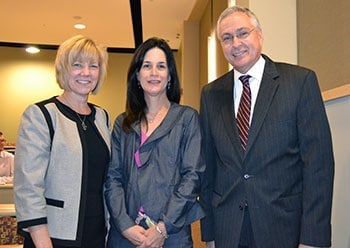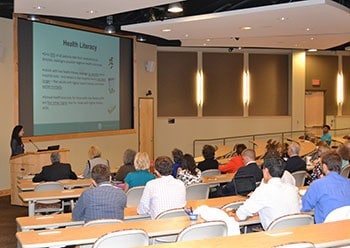Health Literacy Expert Encourages Better Patient Engagement
| 
Laura Noonan, M.D., (center) is greeted by UAMS CEO Roxane Townsend, M.D., and UAMS Chancellor Dan Rahn, M.D. before the lecture.

Laura Noonan, M.D., speaks to UAMS physicians, faculty and students on health literacy Sept. 19.
Sept. 26, 2013 | Eighty million Americans lack sufficient education in health care and disease prevention, a fact that is affecting hospital readmissions statistics, patient-doctor engagement and patient mortality rates, said Laura Noonan, M.D., a health literacy expert who visited UAMS last week.
Noonan shared patient engagement strategies with physicians, faculty and students during a Sept. 19 lecture. Noonan, senior improvement advisor for the Charlotte Area Health Education Center in the Carolinas Healthcare System, is engaged in an effort to educate 10,000 nurses
across two states (North Carolina, South Carolina)
in health literacy strategies.
In Arkansas, nearly 300,000 adults function at
below basic literacy skills, an issue that is directly related to poor patient health literacy in hospital clinics. Statistics like these is what motivated Noonan to spearhead an education initiative, a part of a Carolinas HealthCare System’s QI-based health literacy project for 24 facilities across the third-largest nonprofit health care system in the U.S.
“There is a gap between what we think people understand and what they actually understand,” Noonan said. “Patients only retain about 50 percent of all instructions. Nodding and smiling are not accurate signs that a patient understands what you are saying.”
UAMS Chancellor Dan Rahn, M.D., who introduced Noonan and welcomed attendees to Noonan’s lecture, said he is hopeful that implementing health literacy strategies in hospitals around the country will help health care systems like UAMS to save lives and excess health care spending.
“Seventy five percent of health care funds go to the treatment of chronic diseases, the country’s leading causes of death and disability,” Rahn said. “With improved health literacy, there is hope that we can prevent disabilities and improve quality of life for patients.”
Health literacy, the degree to which an individual can obtain, process and understand basic health information and services to make appropriate health decisions, is suffering in a system that requires patients to jump through too many hoops, Noonan said.
“Expectations for patients are increasing as we ask them to remember immunization schedules and instructions on how to practice self-care at home,” she said. “Most written materials are written well above average literacy levels — 93 million adults have basic or below basic literacy skills.”
Noonan encouraged physicians to use the teach-back method as an approach to patient engagement to make sure patients understand a diagnosis, appointment information, medical literature and medication directions.
“As a doctor, ask patients to repeat in their own words what they are supposed to do before they leave your office,” she said. “’Do you understand?’ is the most common question asked by doctors. The question should be ‘What questions do you have?’”
Noonan also offered the Health Literacy Universal Precautions Toolkit, commissioned by the Agency for Healthcare Research and Quality, as a source for primary care doctors interested in improving health literacy within their practices. The toolkit provides specific actions that doctors and health care workers can take to minimize health risks and to create an environment of clear communication.
Noonan joined the Department of Pediatrics at Carolinas Medical Center (CMC) in 1994, and is a founding organizer and current director of the Center for Advancing Pediatric Excellence in the Department of Pediatrics at Levine Children’s Hospital at CMC. For the last 16 years her focus has been on health care Quality Improvement methodology.